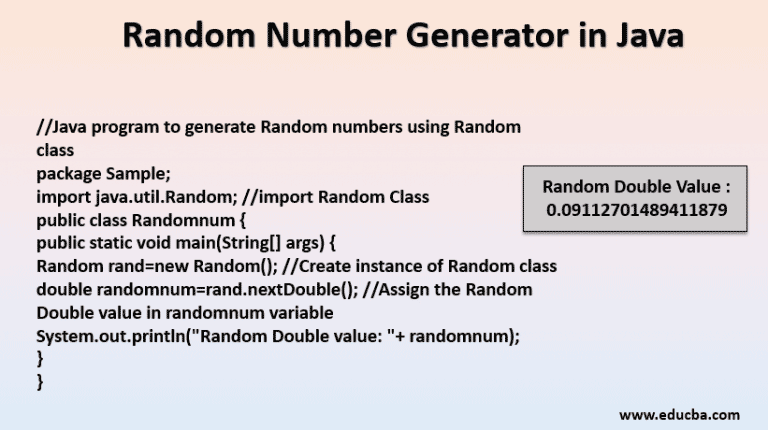

- #MATH.RANDOM JAVA FORMULA GENERATOR#
- #MATH.RANDOM JAVA FORMULA CODE#
- #MATH.RANDOM JAVA FORMULA PASSWORD#
You can create reusable methods that generate random values.Objective #2: Use the Math.random static method in methods. Int prob = Math.floor(Math.random() * 3) The method should be written the following way: The problem is that Math.random is being called twice and the conditional probability of a lose is not 1/3. Write a method that returns "win", "lose", or "draw" each 1/3 of the time.Įlse if (Math.floor(Math.random() * 3 = 1) Be careful not to create a logic error when answering a question like the following.The Math.random value does not need to be seeded like some corresponding methods or functions in other computer languages.

If you wanted something to occur based on a probability of say 40% in a Java game or simulation, then you could use the Math.random method like this.Where HI is the highest integer and LO is the lowest integer in the desired range of integer values. A general formula to use for generating a random integer over a range of values is.In the statement below you must assume that num is a double. The Math.floor method could be used instead of typecasting with the (int) cast operator as long as you store the returned value into a double variable.Num = (int) Math.random() * 6 + 1 // always equals one Num = (int) (Math.random() * 10) - 4 // -4 <= num <= 5īe careful to use the extra set of parentheses in the examples above since Num = (int) (Math.random() * 2) + 1 // 1 or 2 (simulated coin flip) By typecasting the result to an integer and truncating the decimal places, we can ensure that only whole numbers are produced as in:.You can manipulate this returned value by turning it into an integer or "spreading out" the range of possible values.The static method named random in the Math class can be used to create a random decimal value that is greater than or equal to 0.0 and less than 1.0.įor example, the following statement displays a random decimal value such as 0.34.So it is proper to call these values pseudorandom rather than random. It is technically impossible to create a truly random value with a computer since any available built-in method or process for creating a random value relies on some determinate mechanism such as the computer's system clock.
#MATH.RANDOM JAVA FORMULA CODE#
Math.random will select a value from the shuffled array of a finite sequence demonstrated by the code snippet below.Objective #1: Use the Math.random static method for random number generation to create The Fisher-Yates is one great way to prevent getting the same number twice by shuffling the sequence. There are many methods to achieve unique values without repetition.


The randomization is based on the algorithm xorshift128+, which is likely running on your browser. This means its randomization can be reproduced under certain circumstances.
#MATH.RANDOM JAVA FORMULA GENERATOR#
This algorithm is called a pseudo-random number generator (or PRNG). Math.random() returns a pseudo-random number. There are a couple I see come up often… Is Math.random() really random? It’s possible you have questions after seeing Math.random in these examples.
#MATH.RANDOM JAVA FORMULA PASSWORD#
This password generator uses Math.random to get a password array filled with uppercase and lowercase letters then adds random digits to the generated password.


 0 kommentar(er)
0 kommentar(er)
